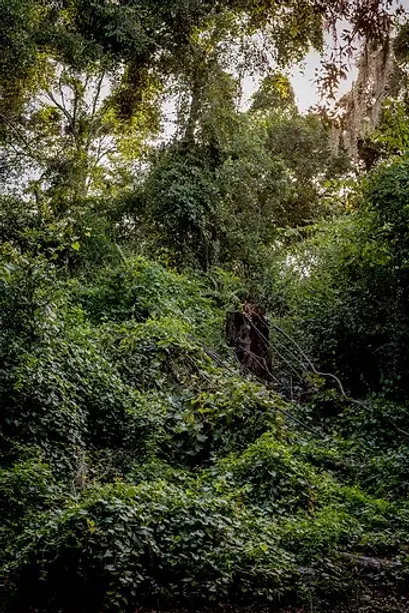top of page
Battlefield USCT

Fort Sumter (view to Morris Island)
The attack on Fort Sumter marked the beginning of the U.S. Civil War. Its venerable position in history is evidenced by the 7-800,000 tourists that visit the site annually. Fort Sumter was actually one of three forts guarding Charleston Bay. Another was Fort Wagner on Morris Island, a mile south of Fort Sumter. While great efforts have been made to preserve Fort Sumter, no attempts were made to maintain or protect Fort Wagner. It has since disappeared, quietly slipping into the sea.

Morris Island 2
Accessible today only by private boat, Morris Island was the site of two Civil War battles - the second much larger and strategically important. During this, the 54th Massachusetts Volunteer Infantry, the first major American military unit made up of Black soldiers, led an assault against what many considered an impregnable Fort Wagner. Out of the 1,100 men of the 54th that charged, 315 survived. The unit's dead were buried on the island in a segregated mass grave.

Morris Island 3
Though technically a Union loss, this battle led to Fort Wagner's abandonment and a Union takeover of Charleston Harbor - a terrible blow for the Confederacy. Word of the 54th's bravery also led to greater acceptance of Black soldiers in the Union army and a surge in Black enlistment. On the island today there are no memorials, and the graves have been covered under decades of debris. Morris Island has become the primary dump site for materials dredged from Charleston Bay.

Fort Wagner 1
The slipping of Fort Wagner into the sea, and the smothering of Black bodies under hundreds of tons of silt and sand parallel what has been done at many sites of Black heroism.

Fort Wagner 2

Natural Bridge 1
Upon rumors the prison camp at Andersonville had relocated to Thomasville, Georgia, the 2nd & 99th U.S. Colored Troop (USCT) Infantry units, along with he 2nd Florida Calvary were charged with capturing Florida's capital and rescuing Union prisoners of war. They were repulsed at Natural Bridge by an entrenched and better equipped Confederate force. This is the only monument on site. It honors the 'valor and patriotism' of the Confederate defenders.

Natural Bridge 4
Though USCT units comprised the majority of Union forces, there is little acknowledgement that Black soldiers actually fought at Natural Bridge. The only recognition I found was on a single display panel. Among images and accounts from white officers, there is a brief excerpt from a Black soldier's journal detailing the difficult campaign and this photograph of an unknown group of Black soldiers with their white officer - a period stock photo.

Natural Bridge 5
Very little of the grounds at Natural Bridge are maintained. Beyond the annual reenactment, I have spent afternoons there without seeing another person. Rather than honoring the sacrifice of those who have come before or empowering a shared identity in the manner memorials are intended to function, this appears to be a space of disconnection, of transience, and ultimately anonymity.

Natural Bridge 7
In her book Regarding the Pain of Others, Susan Sontag declares, "To make peace is to forget. To reconcile, it is necessary that memory be faulty and limited." What happens, however, when there is a refusal to reconcile? When "the faulty memory" is at the service to a further obscuring of an already marginalized people's history? Spaces like this seem to suggest the answer is a quiet slipping away, into obscurity and irrelevance.

Olustee 2
An overconfident Union general defied direct orders and attempted to march 5,000 white troops from Jacksonville to Tallahassee, in an attempt to capture Florida's capital. They were routed by a larger, entrenched Confederate force outside the small town of Olustee. Suffering terrible losses, USCT units were called in from Jacksonville to act as a physical buffer between retreating Union soldiers and Confederate forces harrowing their flank.

Olustee 4
In terms of the percentage of those lost, the Battle of Olustee was the 2nd bloodiest in the Civil War. Union deaths outnumbered Confederate, and Black injuries and deaths among Union forces more than doubled that of White. Again, Black soldiers did not take part in the initial assault, what was thought to be the easy capture of a state capital. They were instead sent out to provide cover for retreating White soldiers, to slow the enemy down, an expendable shield.

Olustee 5
This is a photograph of the diorama at the Olustee Battleground Visitor's Center. Though full of informational displays, charts, archival images and artifacts, no where are USCT soldiers and their contributions acknowledged.

Edisto 1
Fearing invasion after the outbreak of the Civil War, plantation owners on South Carolina's Edisto Island burned their crops, abandoned their holdings, and retreated inland. Word spread, and within a year the island became a refuge for over a thousand escaping enslavement.

Edisto 5
Located twenty-five miles outside of Charleston, one of the most important ports for the South, there were continual skirmishes on Edisto Island between Confederate forces and this growing community of no longer enslaved Blacks. When Union forces arrived, the island's location and the support and eagerness of its residents to enlist, made it a prime staging area for the campaign against Charleston.

Edisto 3
With Union support, the population of the formerly enslaved rose to several thousand, and this number continued to grow after the Confederacy's surrender. Descendants continue to live on the island today as a distinct Gullah community.

Edisto 4
The Gullah community on Edisto Island is today under threat, as its members are gradually being displaced. With Charleston property values rising, Edisto Island is being bought up, rezoned, and sold as vacation and rental properties. A form of rural gentrification is doing what military might could not. With no memorials on the island, this Gullah community's history of heroism and their important role in the defeat of one of the Confederacy's most powerful cities is in danger of being forgotten.

McLeod Plantation
Now an important Gullah/Geechee heritage site, the McLeod Plantation was occupied by Confederate forces during most of the Civil War, serving as a hospital for forces involved in the Secessionville and Edisto battles. After the fall of Charleston, McLeod Plantation was occupied by the 55th Massachusetts Volunteer Regiment USCT, and after that served as local offices for the Freedmen's Bureau. Newly freed Blacks and poor Whites were invited to camp onsite during this period of tremendous adjustment.

McLeod Plantation 2
The rise of post-war Jim Crow era laws after President Johnson's pardoning and restoration of lands to many Confederate families allowed the descendants of McLeod Plantation's former owners to reclaim the site. The Freeman's Bureau was removed and part of the plantation's income stream became the rental of former slave quarters to area Blacks. it was not until 1990, when the plantation was sold, that the last tenants were evicted. No running water or electricity had been installed.

Folly Beach
The launching site for the Union assault on Fort Wagner.
bottom of page